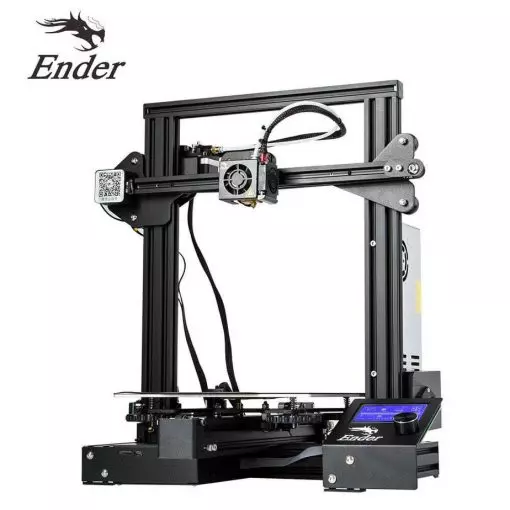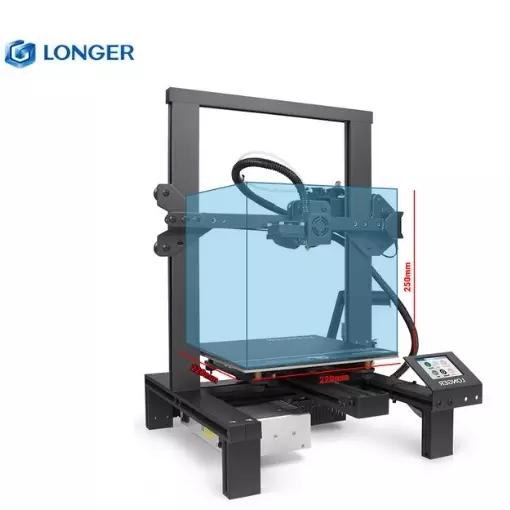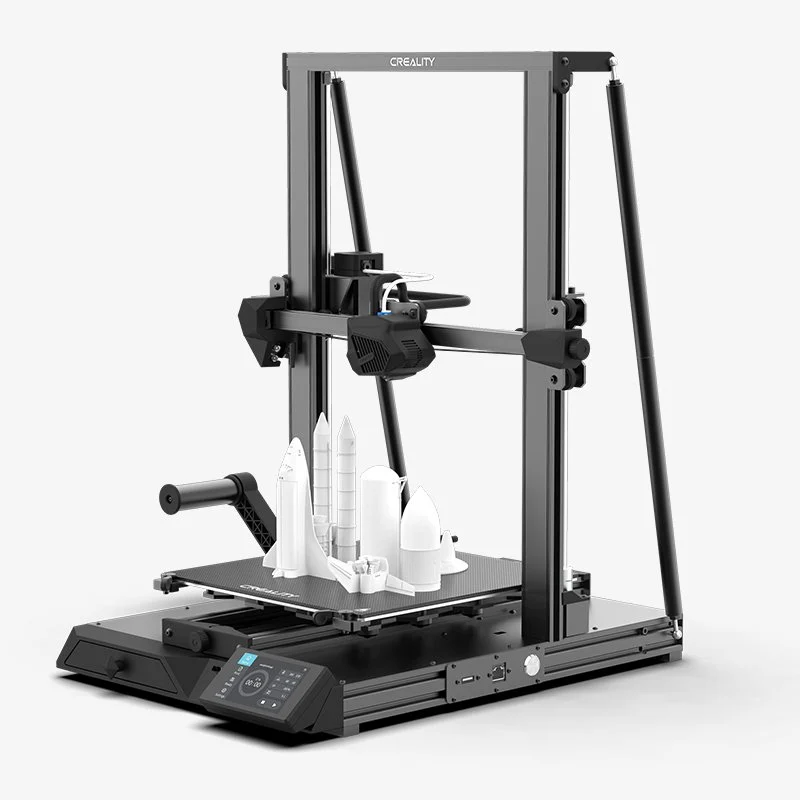Compare Ender 3 vs LK4 vs CR 10 Smart
Comparison between the best 3D printers
Choose the best 3D printer at the best price. The cheapest 3D printers are here.
Buy a 3D printer here with 3D Fila.
 |
 |
 |
|
| Model | Ender 3[BUY Ender 3] |
LK4 |
CR 10 Smart[BUY CR 10 Smart] |
| Printing Material | Filament | Filament | Filament |
| Estimated price | $210,00 | $200,00 | $520,00 |
| Fabricante | Creality 3D | Longer 3D | Creality 3D |
| Release Year | 2018 | 2019 | 2021 |
| Print Volume [mm] | 220x220x250 | 220x220x250 | 300x300x400 |
| Printer Size [mm] | 440x440x465 | 402x425x505 | 578x522x648 |
| Weight [kg] | 6,62 | 7,8 | 14 |
| Power Loss Recovery | NO | YES | YES |
| Enclosed printer | NO | NO | NO |
| Bed Leveling | Manual | Manual com Assistência | Automatic |
| Filament End Sensor | NO | YES | YES |
| Bed type | Heated | Heated | Heated |
| Power supply system | Bowden | Bowden | Bowden |
| Standard nozzle | 0,4 | 0,4 | 0,4 |
| Maximum Nozzle Temperature [°C] | 255 | 250 | 260 |
| Maximum Bed Temperature [°C] | 110 | 100 | 100 |
| Maximum printing speed [mm/s] | 180 | 120 | 200 |
| Filament holder | YES | YES | YES |
| Camera for supervision | NO | NO | NO |
| Recommended filaments | PLA, TPU, ABS, PETG | PLA, TPU, ABS, PETG | PLA, PETG, Tritan, Flex, ABS |
| Recommended slicers | Cura, Simplify, Slic3r | Cura, Simplify, Slic3r | Cura, Simplify, Slic3r, IdeaMaker |
| Maximum Resolution [mm] | 0,1 | 0,1 | 0,1 |
| Processor | 8 bits | 8 bits | Processador ARM STM32F103 RET6 CPU |
| Display | Mono | Touchscreen TFT 2,8'' | Display touchscreen 4,3'' |
| Power Supply | 24V / 270W | 12V / 360W | 110/220V / 350W |
| Connectivity | SD / USB | SD / USB | SD / USB / Wi-Fi |
| Operating systems | Windows, Mac, Linux | Windows, Mac, Linux | Windows, Mac, Linux |
| Date of registration in the system | 2021-04-13 | 2021-04-15 | 2022-11-04 |
| Release date | 2018 | 2019 | 2021 |
| Extra features | The Ender 3 V1 is a DIY assembly 3D printer, a sales leader since 2017, standing out for its cost-benefit. With a wide printing capacity, it has a CNC machined structure for precision and stability. It offers high-precision prints with low noise, thanks to its innovative V-profile and pulleys. It has a self-adhesive magnetic platform for easy removal of models and excellent adhesion. The Ender 3 heats up quickly, reaching 100°C in 5 minutes, ideal for agile prints. It includes protection against power failures, allowing you to resume printing after interruptions, saving time and material. | The Longer LK4 is a versatile 3D printer capable of working with a wide range of filaments, such as PLA, ABS, TPU, copper, wood and carbon fiber, thanks to its 0.4mm nozzle and heated bed up to 110°C. With a printing accuracy of between 0.05-0.4mm, it stands out for its solid construction with an aluminum frame, weighing around 7kg, and a robust 24V and 15A power supply. The kit includes an Allen key, a 7/10 key, a microSD card with USB adapter, a spatula, cable ties, a power cable, 5m of filament and a spare filament end sensor. Assembly is simplified, with around 90% of the equipment pre-assembled, and detailed instructions assist in the process. Special features include print recovery after power failure, a filament end sensor, a super-adhesive printing surface and an intuitive color touchscreen display. The design features smooth profiles for easy assembly, and the position of the filament holder optimizes the filament path to the extruder. The LK4 is a solid choice for 3D printing enthusiasts looking for quality and versatility. | The Creality CR-10 Smart stands out for its stability, with a dual Z axis and additional supports, minimizing oscillation in high prints. Its redesigned hotend offers better cooling, expanding the range of usable materials. The glass printing surface, with automatic leveling, facilitates the adhesion and removal of parts. Includes Wi-Fi / LAN connection and automatic shutdown after printing, adding convenience and efficiency. It features an effective single-gear extruder and an intuitive touchscreen interface, despite some firmware issues. |
| Support for multiple colors and materials (AMS and CFS) | NO | NO | NO |
Notes * |
|||
| Cost-benefit | 6 / 10 | 7 / 10 | 6 / 10 |
| Hardware | 0.5 / 10 | 2 / 10 | 2.4 / 10 |
| Screen | . | . | . |
| Print volume | 3 / 10 | 3 / 10 | 4 / 10 |
| Performance | 1 / 10 | 1 / 10 | 2 / 10 |
| [BUY Ender 3] | [BUY CR 10 Smart] |
Conclusion |
| In comparing the Ender 3, LK4, and CR-10 Smart, each 3D printer brings its own strengths and weaknesses, making them suitable for different user needs and budgets. **Ender 3**: Renowned for its exceptional cost-to-performance ratio, this DIY model has gained popularity since its release. It offers a solid print volume and precision, along with a heated bed and a self-adhesive surface that enhances model adhesion and removal. However, it relies on manual bed leveling and lacks features such as power loss recovery, which could be a consideration for users seeking convenience. **LK4**: This printer balances affordability and functionality with a variety of supported materials and enhanced features. It includes power loss recovery, a filament end sensor, and simplified assembly. The presence of a color touchscreen makes it user-friendly, while a robust aluminum frame provides durability. However, the LK4's lower max print speed and slightly less extensive resolution may not appeal to all users. **CR-10 Smart**: Positioned at a higher price point, this printer excels in print volume and stability, thanks to its dual Z-axis design. Features like automatic bed leveling and connectivity options such as Wi-Fi enhance user convenience. It supports a broad range of materials and has a user-friendly touchscreen interface. However, users may encounter some firmware challenges that could affect its overall performance. In conclusion, if budget constraints are a primary concern, the Ender 3 and LK4 provide excellent value for hobbyists and those new to 3D printing, with slightly more features and easier assembly in the case of the LK4. For users willing to invest more for advanced features, larger print volumes, and better stability, the CR-10 Smart is a compelling choice, notwithstanding the potential for minor firmware issues. Each model targets a different segment of the market, allowing users to select based on their specific needs and printing ambitions. |

